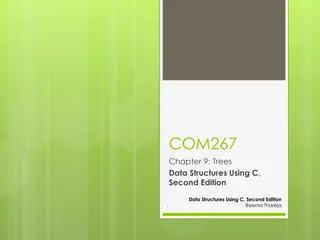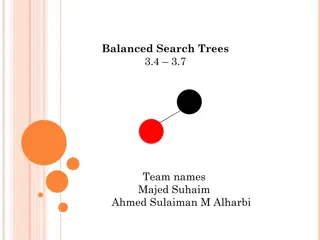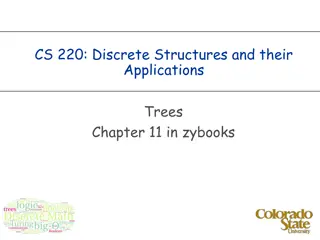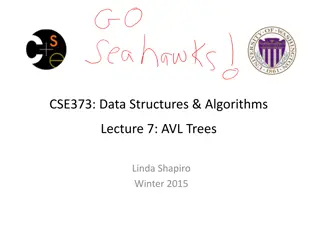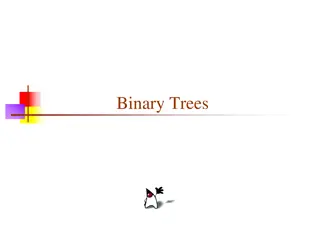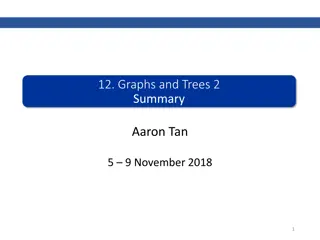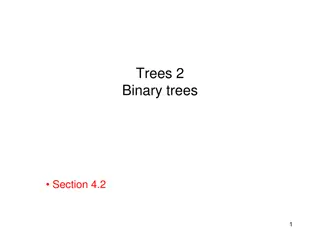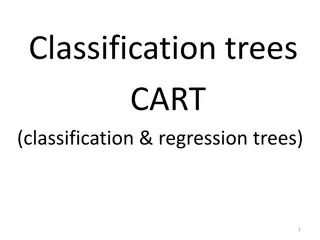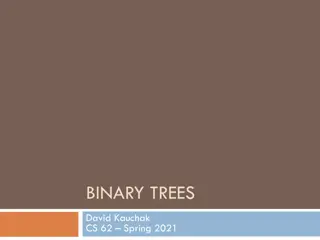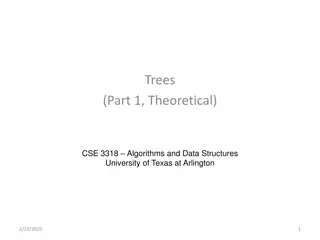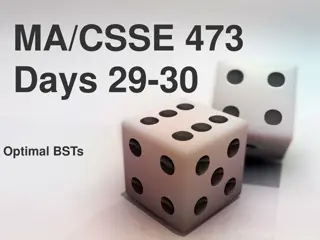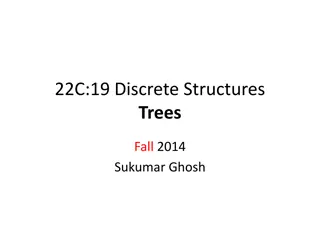
Binary Search Trees and Operations
Explore the concept of Binary Search Trees (BST), their formal definition, operations like searching, insertion, and removal, as well as various methods to manipulate and traverse BST structures.
Download Presentation

Please find below an Image/Link to download the presentation.
The content on the website is provided AS IS for your information and personal use only. It may not be sold, licensed, or shared on other websites without obtaining consent from the author. If you encounter any issues during the download, it is possible that the publisher has removed the file from their server.
You are allowed to download the files provided on this website for personal or commercial use, subject to the condition that they are used lawfully. All files are the property of their respective owners.
The content on the website is provided AS IS for your information and personal use only. It may not be sold, licensed, or shared on other websites without obtaining consent from the author.
E N D
Presentation Transcript
Balanced Binary Search Trees Tengjun Liu
What is a binary search tree (BST)? Formal definition: An empty tree is a BST If the left subtree of a node isn t empty, then all its values are less than the node s value If the right subtree of a node isn t empty, then all its values are greater than the node s value The left and right subtrees of a node are both BSTs
struct Node { int value; Node* lc; Node* rc; int size, height; Node(int v): value(v), lc(nullptr), rc(nullptr), size(1), height(1){} };
Operations of a BST Searching Predecessor/successor Maximum/minimum Insertion Removal Traversal Rank Select
Searching If key is less than node, search its left subtree If key is greater than node, search its right subtree If key is equal to node, return node If node is non-existent, the key doesn t exist Node* find(Node* cur, int v) { if (cur == nullptr) return nullptr; if (cur->value < v) return find(cur->rc, v); if (cur->value > v) return find(cur->lc, v); return cur; }
Insertion If key is less than node, insert into left subtree If key is greater than node, insert into right subtree If node doesn t exist, create new node with key value here Node* insert(Node* cur, int v) { if (cur == nullptr) return new Node(v); if (cur->value < v) cur->rc = insert(cur->rc, v); else cur->lc = insert(cur->lc, v); return cur; }
Removal Use aforementioned methods to find node If is leaf, remove If has one child, replace with child If has two children, replace with left child and make right child the right child of the max in left subtree Node* remove(Node* cur, int v) { if (cur == nullptr) return nullptr; if (cur->value < v) cur->rc = remove(cur->rc, v); else if (cur->value > v) cur->lc = remove(cur->lc, v); else { if (cur->lc == nullptr && cur->rc == nullptr) cur = nullptr; else if (cur->lc != nullptr && cur->rc == nullptr) cur = cur->lc; else if (cur->lc == nullptr && cur->rc != nullptr) cur = cur->rc; else cur = max(cur->lc); } return cur; }
Rank Rank is number of nodes before it + 1 int rnk(Node* cur, int v) { if (cur == nullptr) return -1; if (cur->value > v) return rnk(cur->lc, v); if (cur->value < v) return rnk(cur->rc, v) + cur->lc->size + 1; return (cur->lc != nullptr ? cur->lc->size : 0) + 1; }
Selection If rank <= size of left subtree, select in left subtree If rank > 1 + size of left subtree, select in right subtree and subtract 1 + size of left subtree from rank Otherwise, current node is at rank Node* select(Node* cur, int rank) { if ((cur->lc != nullptr ? cur->lc->size : 0) >= rank) return select(cur->lc, rank); if ((cur->lc != nullptr ? cur->lc->size : 0) < rank-1) return select(cur->rc, rank - (cur->lc != nullptr ? cur->lc->size : 0) - 1); return cur; }
But languages implement BSTs! Data structures like map and set (C++), TreeMap and TreeSet (Java), etc. are based on BSTs So why write our own? They don t have rank and selection!
Time complexity of BSTs Searching related operations: O(log(n)) Insertion: O(log(n)) Removal: O(log(n)) in theory
So whats wrong? BSTs can be very imbalanced An unbalanced BST could have a time complexity of O(n) for its operations Trees need to be self-balancing to create balanced binary search trees (BBST)
Rotation Changes the relationship between a parent-child pair Still preserves the properties of a binary tree
Rotation Right rotation (just reverse left-right for left rotation): Changes right child of old child into left subtree of old parent Changes old parent into right child of old child Returns child (to become child of the grandparent) Node* rRotate(Node* cur) { Node* left = (*cur).lc; (*cur).lc = (*left).rc; (*left).rc = cur; (*cur).height = fmax(((*cur).lc != nullptr ? (*(*cur).lc).height : 0), ((*cur).rc != nullptr ? (*(*cur).rc).height : 0)) + 1; (*cur).size = ((*cur).lc != nullptr ? (*(*cur).lc).size : 0) + ((*cur).rc != nullptr ? (*(*cur).rc).size : 0) + 1; (*left).height = fmax(((*left).lc != nullptr ? (*(*left).lc).height : 0), ((*left).rc != nullptr ? (*(*left).rc).height : 0)) + 1; (*left).size = ((*left).lc != nullptr ? (*(*left).lc).size : 0) + ((*left).rc != nullptr ? (*(*left).rc).size : 0) + 1; return left; }
Types of BBST Red-black trees AVL trees Scapegoat trees Treaps
Red-black tree All nodes are labelled red or black The root is black The leaves are null and are labelled black The children of red nodes must be black On every path from the root to a leaf node, the number of black nodes are the same
Properties Reasonably fast search Worst case is O(2log(n)), which is still logarithmic Fast insertion Only occasionally need rotations but you don t really need to know it Very hard to implement Multitudes of subcases for operations
AVL trees A strictly balanced BST Difference in height between subtrees is at most 1 Need to keep track of node heights Very fast query Somewhat slower insertion (but still logarithmic) Requires frequent rotations to maintain balance A bit easier to implement than red-black trees
AVL tree maintenance Since only one node is inserted/removed, the difference in heights is at most 2 However, we need to recursively maintain the properties at every single node, which makes things slow
Node* maintain(Node* cur) { if (cur == nullptr) return nullptr; int lh = 0, rh = 0; if ((*cur).lc != nullptr) lh = (*(*cur).lc).height; if ((*cur).rc != nullptr) rh = (*(*cur).rc).height; if (abs(lh-rh) > 1) { if (lh>rh) { int llh = 0, lrh = 0; if ((*cur).lc != nullptr && (*(*cur).lc).lc != nullptr) llh = (*(*(*cur).lc).lc).height; if ((*cur).lc != nullptr && (*(*cur).lc).rc != nullptr) lrh = (*(*(*cur).lc).rc).height; if (llh >= lrh) cur = rRotate(cur); else { (*cur).lc = lRotate((*cur).lc); cur = rRotate(cur); } } else { int rlh = 0, rrh = 0; if ((*cur).rc != nullptr && (*(*cur).rc).lc != nullptr) rlh = (*(*(*cur).rc).lc).height; if ((*cur).rc != nullptr && (*(*cur).rc).rc != nullptr) rrh = (*(*(*cur).rc).rc).height; if (rrh >= rlh) cur = lRotate(cur); else { (*cur).rc = rRotate((*cur).rc); cur = lRotate(cur); } } } return cur; }
Scapegoat trees Reasonably fast search Logarithmic, but depends on the ratio constant Insertion/deletion: Amortized O(log(n)) Worst case O(n) But it is really easy to code!
Ratio constant Usually denoted by 0.5 < < 1, usually chosen to be 0.7 to 0.8 It is the maximum percentage a subtree may occupy of the whole tree i.e., ???? ??????? ???? ? ??? ???? ???? ? and ??? ? ??????? ???? ? ??? ???? ???? ? If one of the subtree sizes gets too big, we reorganize the whole tree
and how do we reorganize? Take out the whole tree, store it in an array, and reconstruct it!!! Node* reorganize(Node* cur) { vector<int>* vec; traverse(cur, vec); cur = build(vec, 0, (*vec).size()); return cur; } // [a, b) Node* build(vector<int>* vec, int a, int b) { if (a >= b) return nullptr; int mid = (a + b) / 2; Node* cur = new Node((*vec)[mid]); cur->lc = build(vec, a, mid); cur->rc = build(vec, mid+1, b); return cur; }
Treaps Based on heaps In a heap, every node is smaller (or bigger, depending on what type you re using) than its children A treap is a BST and a heap put together Apart from the value, we also store a random priority The values follow the structure of a BST, while the priorities follow the structure of a heap
void _insert(Node* cur, int val) { if (cur == nullptr) { cur = new Node(val); return; } else if (val < cur->value) { _insert(cur->lc, val); if (cur->lc->priority < cur->priority) { rRotate(cur); } } else if (val > cur->value) { _insert(cur->rc, val); if (cur->rc->priority < cur->priority) { lRotate(cur); } } }
Sources https://oi-wiki.org/ds/ Rotationless treap: https://oi-wiki.org/ds/treap/#%E6%97%A0%E6%97%8B-treap Algorithms Illuminated (Part 2) Graph Algorithms and Data Structures by Tim Roughgarden Algorithms by Robert Sedgewick and Kevin Wayne
Images https://commons.wikimedia.org/wiki/File:Binary_search_tree.svg https://commons.wikimedia.org/wiki/File:Binary_search_tree_example.gif https://commons.wikimedia.org/wiki/File:Binary-search-tree-insertion- animation.gif https://commons.wikimedia.org/wiki/File:Binary-search-tree-degenerating- demo-animation.gif https://commons.wikimedia.org/wiki/File:Tree_rotation_animation_250x250. gif https://commons.wikimedia.org/wiki/File:Red- black_tree_example_with_NIL.svg https://oi-wiki.org/ds/treap/


